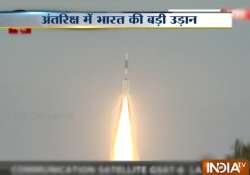ISRO successfully places GSAT-6 in geosynchronous orbit
Sriharikota (Andhra Pradesh): An Indian rocket with over two tonne communication satellite GSAT-6, which has several strategic applications, blasted off from the Sriharikota spaceport here on Thursday.Precisely at 4.52 p.m., the Geosynchronous Satellite Launch Vehicle-Development

Sriharikota (Andhra Pradesh): An Indian rocket with over two tonne communication satellite GSAT-6, which has several strategic applications, blasted off from the Sriharikota spaceport here on Thursday.
Precisely at 4.52 p.m., the Geosynchronous Satellite Launch Vehicle-Development 5 (GSLV D6) rose from the second launch pad here at Satish Dhawan Space Centre.
The 49.1 metre tall rocket weighing 416 tonnes would sling the 2,117 kg GSAT-6 communication satellite in the geosynchronous transfer orbit (GTO) around 17 minutes into the flight.
Indian Space Research Organisation (ISRO) scientists at the mission control centre here watched their monitors intently to see the rocket's progress.
ISRO today successfully launched Geo-synchronous Satellite Launch Vehicle (GSLV D6) carrying communication satellite GSAT-6 from the Satish Dhawan Space Centre in Sriharikota.
The satellite GSAT-6 is India's 25th geostationary communication satellite and twelfth in the GSAT series. Five of GSAT-6's predecessors were launched by GSLV during 2001, 2003, 2004, 2007 and 2014 respectively.
The satellite provides communication through five spot beams in S-band and a national beam in C-band for strategic users. The cuboid shaped GSAT-6 has a lift-off mass of 2,117 kg. Of this, propellants weigh 1,132 kg and the dry mass of the satellite is 985 kg.
One of the advanced features of GSAT-6 satellite is its S-Band Unfurlable Antenna of six metre diameter. This is the largest satellite antenna realised by ISRO. This antenna is utilised for five spot beams over the Indian main land. The spot beams exploit the frequency reuse scheme to increase frequency spectrum utilisation efficiency. The satellite's life expectancy is nine years.
One of the crucial rocket engines is the cryogenic engine, more efficient as it provides more thrust for every kilogram of propellant burnt, designed and developed by ISRO.
This is the GSLV rocket with domestically-built cryogenic engine that is flown after nearly a year, in its second mission during the last five years after two such rockets failed in 2010.
One of the failed GSLV rockets flew with an Indian cryogenic engine and the other with a Russian engine.
The GSLV is a three stage/engine rocket. The core of first stage is fired with solid fuel while the four strap-on motors by liquid fuel. The second is the liquid fuel and the third is the cryogenic engine.
For the country, ISRO perfecting the cryogenic engine technology is crucial as precious foreign exchange can be saved by launching communication satellites on its own.
Currently ISRO flies its heavy communication satellites by European space agency Ariane.
India pays around Rs.500 crore as launch fee for sending up a 3.5 tonne communication satellite. The satellite cost is separate.
The ISRO can send smaller communication satellites - weighing around two tonnes - till such time it gets ready an advanced GSLV variant-GSLV-Mark III that can lug satellites weighing around four tonnes.
Watch Video:
( With Inputs from IANS)
